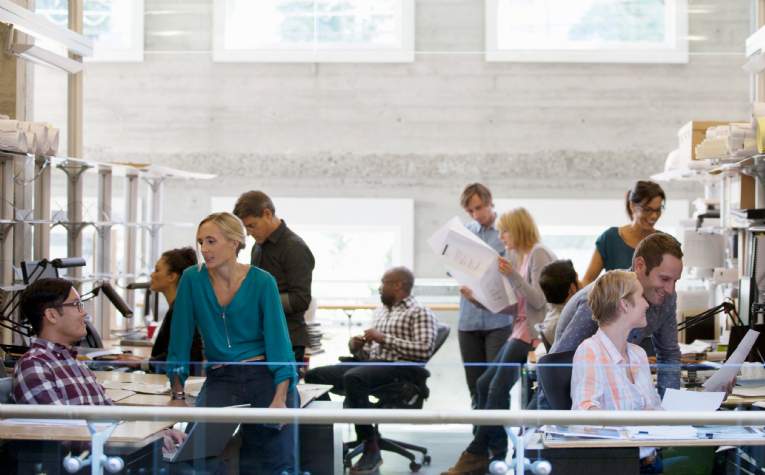Most people underestimate the impact of office furniture on workplace effectiveness. In reality, furniture is a significant component of any office for several reasons. The right furniture not only makes its users more comfortable and productive but also shapes an organization’s brand, supports its culture, and can even help attract and retain employees.
Pre-pandemic, organizations focused on efficiency and density over functionality, personal comfort, and safety. Furniture had a very specific role to play in achieving the desired density. Now, organizational leaders are in a tug of war with employees who want a better work experience if they are expected to be in the office. In this context, furniture serves an entirely different purpose.
How can employers leverage furniture to build a better employee experience at work? To understand this, organizations must first determine the purpose of their workplaces after the lessons learned in the pandemic.
Why Employees Need the Office Now
Every employer must take the time to analyze what role office space plays in achieving their business goals and engaging their employees. Our own research uncovered that even after the normalization of working from home in 2020-21, employees across generations expressed a preference for full-time office work or a hybrid arrangement. A significant percentage of respondents felt that the office is essential in adequately supporting both collaboration and focus work as well as fostering relationships. Let’s look at the realities of each of these needs in 2023:
Collaboration
Collaboration has a much broader definition now than it did pre-pandemic. It is no longer simply a matter of sitting around a conference table with coworkers. Collaboration now frequently happens not just over Zoom but in hybrid scenarios where one member or several members of a team may be remote while others are participating in the office. As before the pandemic, we also know that collaboration can be impromptu and happen in informal settings – in hallways, kitchens, cafes, and other common spaces. Furniture solutions must support this wide range of possibilities and needs.
Focus Work
Many employees who need or prefer quiet space struggled with open office environments prepandemic. After a prolonged experience of working from home and remaining productive, the demand for adequate focus space is getting louder. If corporate offices are to compete with home office environments, they must consider what tools will help build focus spaces that employees can truly benefit from. Current furniture solutions for focus work are more varied and innovative than ever.
Fostering Relationships
Allsteel, a large contract office furniture manufacturer, identified studies that suggest that “social cohesion is… highly correlated to individual performance, motivation, engagement, and learning outcomes; it also helps workers manage fear, stress, and anxiety; which in turn reduces burnout.” Fostering relationships and social cohesion can be difficult no matter where you are and especially challenging when some employees are working remotely. Prolonged working from home has highlighted the value of the workplace as a venue for building and strengthening workplace relationships. Furniture can help facilitate this vital process that strengthens teams and improves employee performance.
Ensuring that your office has the space typology and the flexible furniture to support collaboration, focus work, and relationship building is key to creating a workplace where employees thrive. Variety and flexibility of furniture selections are foundational principles here, making the work environment more adaptable if floor plans change or a company relocates.
Customized Clusters for Every Work Style
Co-locating clusters of community, team, and focus spaces is a dynamic approach to workspace planning that can accommodate a diverse range of furniture products for different needs. Getting the balance right can stimulate innovative thinking and enable a free-flowing exchange of ideas. Some key strategies include:
Social / community spaces
Community spaces should serve as the hub of a hybrid office ecosystem, offering employees an enjoyable setting for reconnecting with coworkers across the office. These areas should sit in proximity to food and drink, with a choice of informal seating and relaxed gathering areas.
- Provide space for small groups: This can be done with small banquettes designed for no more than four people.
- Encourage mingling: High-top and standard seated-height tables of varying sizes can accommodate groups large and small and are ideal for socializing spontaneously or at organized events.
- Support quick catchups: Installing sofas with cafe or laptop tables allows for quick and informal catch-ups over coffee.
Spaces closest to this hub should be collaborative, team-based areas. Focus spaces and adjacent private meeting rooms would be located the furthest from the community hub.
Team Spaces
Where a team resides together should offer enough options to support all the ways in which the team works. Think of team areas as ecosystems of collaboration-style benching stations, with smaller enclosed and semi-enclosed huddle spaces that utilize informal & flexible furniture.
- Enable multiple uses: Acoustic panels, taller storage pieces, and room dividers allow employees to use the same space for multiple tasks.
- Encourage mobility: A high-top, communal-style table allows for both seated and standing work and can be utilized for team meetings/standups, group collaboration, or even focus work in a quietcar setting.
- Use informal but supportive furniture: Informal lounge furniture is a great fit for internal meeting spaces. The right products can be reoriented based on task or meeting type. Contrary to popular belief, “informal” in a work setting does not necessarily refer to a plush sofa or armchair you might put in your living room at home. The West Elm Work Belle is just one example of a loungey yet upright and firm sofa that can be reconfigured to allow teams to collaborate comfortably with healthy posture and ergonomic support.
- Leave no nook behind: To maximize your real estate, take those little nooks and crannies every office seems to have and turn them into something functional. Manufacturers such as Buzzi Space offer creative sound absorbing solutions that can be installed on walls in tight spaces or other overlooked areas to create standing/step-aside areas for phone calls.
Focus Spaces
Privacy, acoustics, comfort, and ergonomics are essential features to consider in selecting furniture for heads-down work. Start by building these spaces away from the main corridors and furthest from the central social hub. In support of wellness, locating heads-down areas at the perimeters with better access to natural light is ideal.
- Cultivate privacy: The classic image of a quiet area is a sea of high-paneled cubicles. Furniture solutions today offer far more choices. Privacy screens and gallery-style panels are flexible options that can be added and rearranged at desks to create visual barriers while seated. Freestanding or ceiling-mounted acoustic panels divide spaces and create sound insulation. Personal work pods also offer unique, moveable options for headsdown work. Examples include The Haworth Cabana Lounge and Steelcase Brody Lounge Chair.
- Support physical health: Focus work can require hours of concentration at a time. Making these hours as comfortable as possible for the individual will support productivity and good health. Select task chairs that support the whole body, not just for aesthetics. With so much medical evidence pinpointing the health dangers of all-day sitting, adjustable-height desks should now be the standard. Finally, encourage movement with a range of furniture types, from benching to work pods to bar-height communal tables, so users can change their posture and remain mobile even as they engage in longer, focused tasks.
Co-locating multiple functions gives employees convenience, choice, and the opportunity to connect with each other when and as they need. Beyond the floor plan itself, selecting furniture that nudges, encourages, and welcomes each of these activities is fundamental for success.
Furniture and Technology Go Hand In Hand
A common thread that runs across all these space types is technology. The average person carries one to three electronic devices throughout the day. Furniture that supports these devices is crucial in maintaining productivity.
First, organizations should ensure that a furniture rep or designer is involved in upfront planning conversations with the AV or IT departments. Selecting office furniture after AV/IT decisions are made can result in costly change orders after furniture is installed.
Furniture choices must provide wireless charging or easily accessible power receptacles integrated at desks, communal tables, and communal seating in community hub areas. In meeting spaces, seamless AV/IT technology is a must in today’s hybrid environments to ensure meeting equity, regardless of whether an attendee is in the office or off-site. In-office users should be able to sit down, plug in, and easily access meeting technology that allows users from any location to share content and be seen and heard.
Testing Strategies
With a world of furniture products out there, how can an organization begin to understand and narrow down its options? Before committing to any major investments, there are some key ways companies can explore a range of space scenarios:
Pilot Space
Start small. Dedicate a small portion of your footprint to reconfigure existing furniture or replace it with new furniture to test the efficacy of various workspaces. This is a cost-effective way to observe, in real-time, whether specific space configurations and furniture products work.
Collect Data
Implement booking software for both meeting and focus spaces to better understand employee patterns and behaviors over time. This valuable data will inform space planning and furniture choices, improving the overall user experience.
Engage a Workplace Strategist
A seasoned workplace strategy team can connect employers with the expertise they need to implement, analyze results, and create an action plan using either of the options above.
Furniture is Strategy
The workplace experience must adapt to new employee expectations for companies to get the most from their real estate investments. Workplace strategy is a toolkit of many parts. Many employers may regard furniture as a minor design consideration in that toolkit, but the seats, surfaces, and fixtures that build out the space directly impact organizational culture and productivity. Furniture is not just a component of design – it delivers a strategy for employee and company success.

.jpg)

.jpg)
.jpg)

.jpg)
.png)
(1).jpg)
